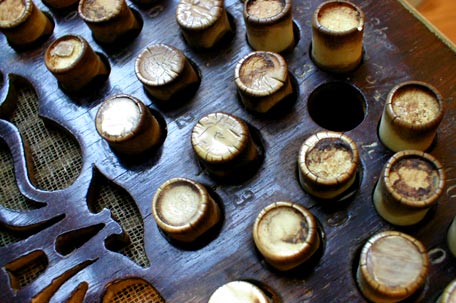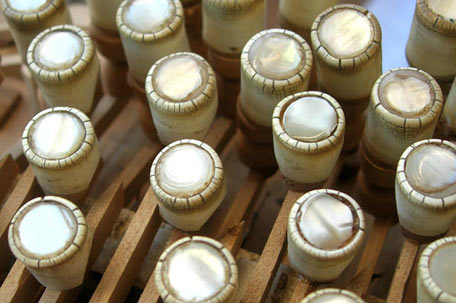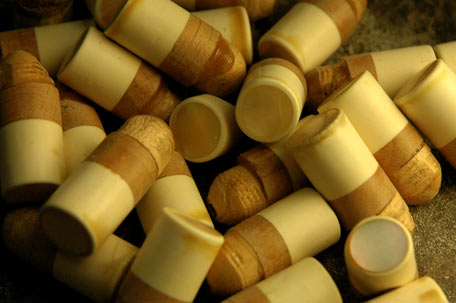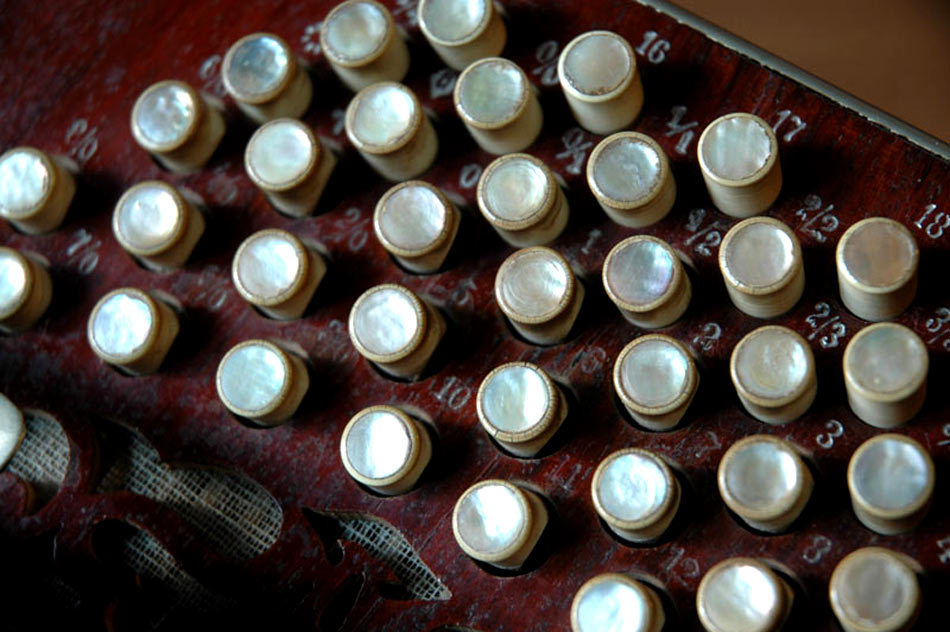

| Carsten Heveling |
| Bando-Aspekte Bandoneon aspects aspectos aspects aspetti |
... zurück back volver retour indietro |
| Knöpfe Material, Eigenschaften, Ästhetik und Restaurierbarkeit |
Buttons Material, characteristics, aesthetics and restorability |
||||||||||||
| Beim Exportmodell findet man ausschließlich die typischen weißen Knöpfe mit einer Einlage aus Perlmutt. Die Knöpfe sind aus Galalith, einem Material der Zeit. Galalith ist ein duroplastischer Casein-Kunststoff (Kunsthorn). Das Casein wurde damals aus Milch gewonnen (Milcheiweiß). So setzt sich auch der Name aus dem griechischen Milch "Gala" und Stein "Lithos" zusammen. Galalith hat wunderbare Eigenschaften für die Verwendung als Tasten am Bandoneon. Es ist ähnlich dem Bein (Knochen oder Elfenbein) sehr hart und hat doch ein weiches, kühles Griffgefühl welches sich von dem Griffgefühl eines jeden synthetischen Kunststoffs auf Petrolbasis unterscheidet. Die Oberfläche der Knöpfe ist eher warm weiß, matt und hygroskopisch, nimmt also Feuchtigkeit auf. Man erkennt die Gespieltheit eines Instrumentes an den typisch verfärbten Knöpfen. Die Knöpfe der in den Tanzsälen von Buenos Aires gespielten Instrumente waren vermutlich regelmäßig Feuchtigkeit ausgesetzt. Mit der Feuchtigkeit ziehen Partikel in das Material sodaß die Verfärbungen nicht oberflächlich sind und leicht entfernt werden könnten. So sind die typischen Verfärbungen von Instrument zu Instrument sehr individuell. Mit der Feuchtigkeitsaufnahme und Abgabe entstehen über die Jahrzehnte feine Haarrisse. Solche Risse sind als Krakelee (Craquelé, frz. rissig, gesprungen) oder Crazes (engl. Haarrisse) bei Gemälden, in der Keramik oder bei antiken Gegenständen ein Zeichen für Authentizität, weshalb es viele Techniken gibt, diese zu künstlich hervorzurufen. Diese feinen Risse, oder in diesem Falle exakter; Alterssprünge, gefährden nicht die Stabilität der Knopfes. Abplatzungen an klassischen Knöpfen habe ich noch nicht gesehen. So ist die Restaurierung der Originalknöpfe oft aufwendig, jedoch mit gutem Ergebnis möglich. Mittlerweile gibt es eine Auswahl von neuen Knöpfen aus Polyester oder auch Galalith. In der Restaurierung ist es immer die Frage, welches Spielgefühl und ästhetische Integrität neue Knöpfe in einem klassischen Instrument vermitteln. Der Klang der Tastatur ist nicht zu unterschätzen. Selbstverständlich beeinflussen die Knöpfe den Klang in keiner Weise direkt, jedoch wirkt das Spielgefühl direkt auf den Spieler und das wiederum reflexiv auf den Klang. Was sich gut anfühlt, klingt auch gut. ... siehe auch "Restaurierung, code D, Tastatur (Knöpfe)"
... siehe auch Link www.galalith Buttons Material, characteristics, aesthetics and restorability The export model only has the typical white buttons with a silver mother-of-pearl inlay. The buttons are made of Galalith, a material of the time. Galalith is a duroplastic casein plastic (artificial bone). At that time casein was obtained from milk (milk protein). The name is made up of the Greek milk "Gala" and stone "Lithos". Galalith has wonderful characteristics for use as buttons on the Bandoneon. Similar to bone (or ivory), it is very hard and yet has a soft, cool feel which differs from the feel of any synthetic plastic based on petrol. The surface of the buttons is rather warm white, matt and hygroscopic, so it absorbs moisture. You can recognize the playfulness of an classic instrument by the typically discolored buttons. The buttons on the instruments played in the dance halls of Buenos Aires were probably regularly exposed to moisture. With the moisture particles pull into the material so that the discoloration is not superficial and can be easily removed. The typical discolorations are very individual from instrument to instrument. With the absorption and release of moisture, fine hairline cracks develop over the decades. Such cracks as craquelure ("craquelé" french for "cracked") or crazes in paintings, in ceramics or in antique objects are a sign of authenticity, which is why there are many techniques to evoke them too artificially. These fine cracks do not endanger the stability of the button. I haven't seen any chipping on classic buttons yet. Restoring the original buttons is often time-consuming, but possible with good results. There is now a selection of new buttons made of polyester or even Galalith. When it comes to restoration, the question is always what feel and aesthetic integrity new buttons convey in a classic instrument. The sound of the keyboard is not to be underestimated. Of course, the buttons do not directly influence the sound in any way, but the feel of the keyboard has a direct effect on the player and that in turn has a reflexive effect on the sound. What feels good also sounds good. ... see also "Restoration, code D, keyboard (buttons)"
... see also link www.galalith |




|



|
| © 1998-adhuc BANDO BANDO Wuppertal | |
| Kontakt / Impressum Datenschutzhinweis & Hinweise zur Nutzung |